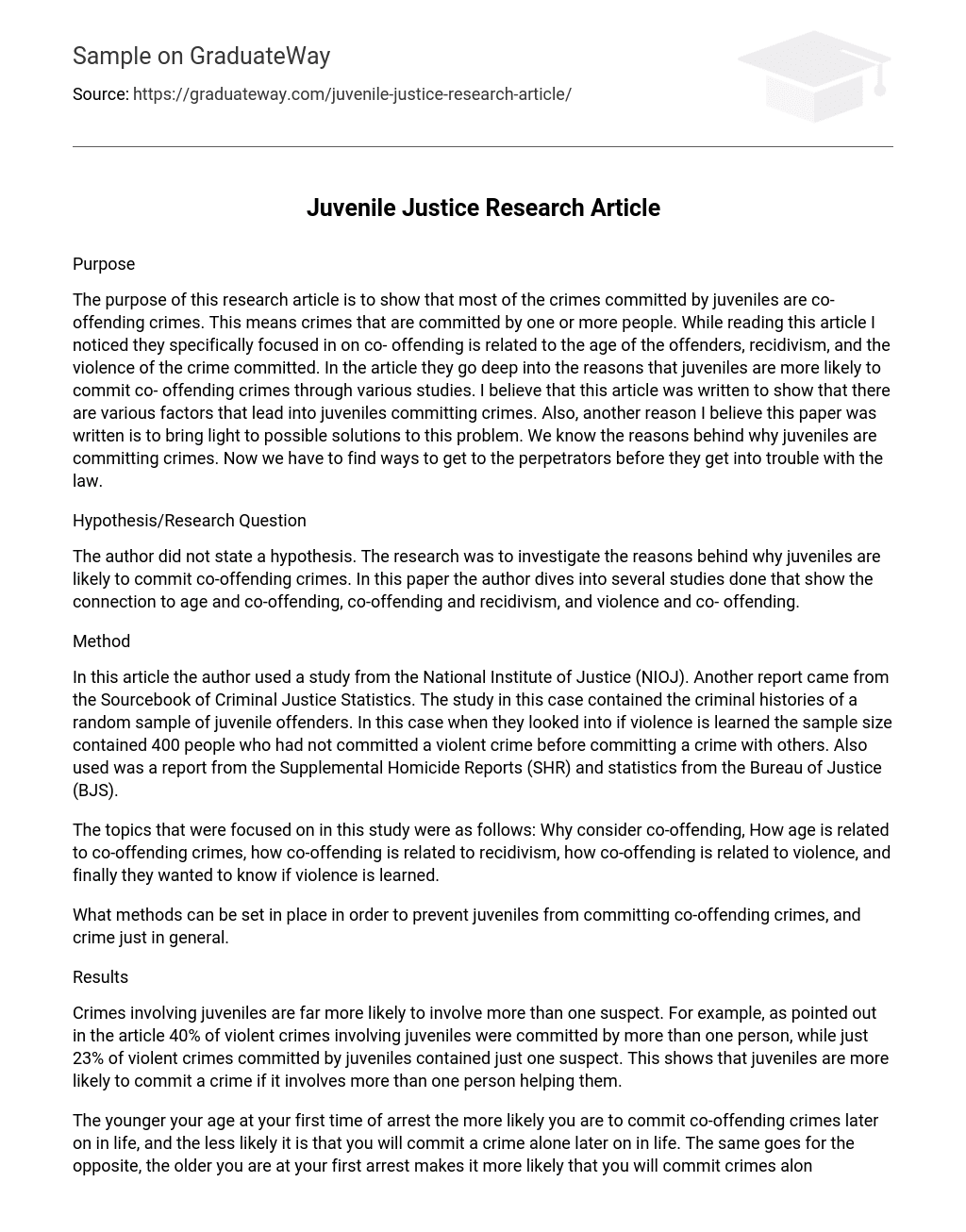Purpose
The purpose of this research article is to show that most of the crimes committed by juveniles are co- offending crimes. This means crimes that are committed by one or more people. While reading this article I noticed they specifically focused in on co- offending is related to the age of the offenders, recidivism, and the violence of the crime committed. In the article they go deep into the reasons that juveniles are more likely to commit co- offending crimes through various studies. I believe that this article was written to show that there are various factors that lead into juveniles committing crimes. Also, another reason I believe this paper was written is to bring light to possible solutions to this problem. We know the reasons behind why juveniles are committing crimes. Now we have to find ways to get to the perpetrators before they get into trouble with the law.
Hypothesis/Research Question
The author did not state a hypothesis. The research was to investigate the reasons behind why juveniles are likely to commit co-offending crimes. In this paper the author dives into several studies done that show the connection to age and co-offending, co-offending and recidivism, and violence and co- offending.
Method
In this article the author used a study from the National Institute of Justice (NIOJ). Another report came from the Sourcebook of Criminal Justice Statistics. The study in this case contained the criminal histories of a random sample of juvenile offenders. In this case when they looked into if violence is learned the sample size contained 400 people who had not committed a violent crime before committing a crime with others. Also used was a report from the Supplemental Homicide Reports (SHR) and statistics from the Bureau of Justice (BJS).
The topics that were focused on in this study were as follows: Why consider co-offending, How age is related to co-offending crimes, how co-offending is related to recidivism, how co-offending is related to violence, and finally they wanted to know if violence is learned.
What methods can be set in place in order to prevent juveniles from committing co-offending crimes, and crime just in general.
Results
Crimes involving juveniles are far more likely to involve more than one suspect. For example, as pointed out in the article 40% of violent crimes involving juveniles were committed by more than one person, while just 23% of violent crimes committed by juveniles contained just one suspect. This shows that juveniles are more likely to commit a crime if it involves more than one person helping them.
The younger your age at your first time of arrest the more likely you are to commit co-offending crimes later on in life, and the less likely it is that you will commit a crime alone later on in life. The same goes for the opposite, the older you are at your first arrest makes it more likely that you will commit crimes alone later on in life. At first arrest you are more likely to have committed a crime with a group of people. For example, in exhibit 3 we see that 40% of offenders committed a crime with an accomplice at first arrest.
The younger you first get into trouble with the law, the more likely you are going to see recidivism in this persons case. Also if your first time getting into trouble with the law is co- offending than the greater the chance is you are going to commit more crimes in the future. For example, a research was done on 411 male criminals in London. They discovered that recidivism declined with increasing age at first offense, and also that co-offending delinquent’s committed crimes at a higher rate than solo offenders did.
If you commit a crime with others, the more likely it is going to be a violent crime. They found that it is more likely for young starters in co-offending to commit violent crimes then it is for older starters. Peer pressure could definitely play a big role in this outcome.
Violent crimes are learned according to a research done in the article. A group of 236 people who had never committed a violent crime before committing a violent crime with others. Among the 236 surveyed 90 committed violent crimes when around a group of people. So basically when they took a group of offenders who never committed a violent crime before, and mixed them all together the more likely they were to then go out and commit a violent crime.
Discussion/Conclusions
After reading this article I took away several things. One is that crimes that involve juveniles are more likely to be co-offending crimes then it is to be a solo crime. Second, is that juveniles are more likely to commit co-offending violent crimes than they are to commit violent acts alone. These could be due to peer pressure, and also could be from gang activity. A way that we could try and solve this issue of juveniles committing co-offending crimes is by trying to get kids to stay in school, and get them involved in extracurricular activities. This is obvious a big problem in our country and needs to be addressed.
Critical Review
This article relates to the podcast caught because it involves a co-offending crime topic. In the podcast we meet a teen named Z who fits this research perfectly. In the podcast Z started to get into trouble with the law at a young age. And as he got older he got into big trouble when he and his friends got arrested for an armed robbery. This supports all of the research done in this paper. That the younger you get involved with the law, the more likely it is you are going to commit a co-offending violent crime as you get older.





